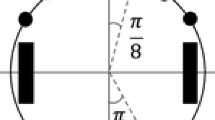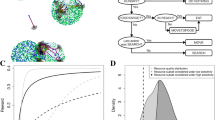Abstract
Communication plays a central role in the biology of most organisms, particularly social species. Although the neurophysiological processes of signal production and perception are well understood, the conditions conducive to the evolution of reliable systems of communication remain largely unknown. This is a particularly challenging problem because efficient communication requires tight coevolution between the signal emitted and the response elicited. We conducted experimental evolution with robots that could produce visual signals to provide information on food location. We found that communication readily evolves when colonies consist of genetically similar individuals and when selection acts at the colony level. We identified several distinct communication systems that differed in their efficiency. Once a given system of communication was well established, it constrained the evolution of more efficient communication systems. Under individual selection, the ability to produce visual signals resulted in the evolution of deceptive communication strategies in colonies of unrelated robots and a concomitant decrease in colony performance. This study generates predictions about the evolutionary conditions conducive to the emergence of communication and provides guidelines for designing artificial evolutionary systems displaying spontaneous communication.
Access this chapter
Tax calculation will be finalised at checkout
Purchases are for personal use only
Preview
Unable to display preview. Download preview PDF.
Similar content being viewed by others
References
Bourke, A. F. G., & Franks, N. R. (1995). Social evolution in ants. Princeton: Princeton University Press.
Dyer, F. C. (2002). Biology of the dance language. Annual Review of Entomology, 47, 917–949.
Fiegna, F., Yuen-Tsu, N. Y., Kadam, S. V., & Velicer, G. J. (2006). Evolution of an obligate social cheater to a superior cooperator. Nature, 441, 310–314.
Floreano, D., Mitri, S., Magnenat, S., & Keller, L. (2007). Evolutionary conditions for the emergence of communication in robots. Current Biology, 17, 514–519.
Fogel, D., Fogel, L., & Porto, V. (1990). Evolving neural networks. Biological Cybernetics, 63, 487–493.
Griffin, A. S., West, S. A., & Buckling, A. (2004). Cooperation and competition in pathogenic bacteria. Nature, 430, 1024–1027.
Hamilton, W. D. (1964). The genetical evolution of social behaviour. Journal of Theoretical Biology, 7.
Hamilton, W. D. (1996). Narrow roads of gene land, vol. 1: evolution of social behaviour. New York: Freeman.
Jacob, F. (1981). Le jeu des possibles. Paris: Librairie Arthème Fayard.
Johnstone, R. A., & Grafen, A. (1992). The continuous Sir Philip Sidney game: a simple model of biological signalling. Journal of Theoretical Biology, 156, 215–234.
Keller, L. (Ed.) (1999). Levels of selection in evolution. Princeton: Princeton University Press.
Maynard-Smith, J. (1991). Honest signaling—the Philip Sidney game. Animal Behavior, 42, 1034–1035.
Maynard-Smith, J., & Harper, D. (2003). Animal signals. London: Oxford University Press.
Maynard-Smith, J., & Szathmàry, E. (1997). The major transitions in evolution. New York: Oxford University Press.
Mirolli, M., & Parisi, D. (2008). How producer biases can favor the evolution of communication: an analysis of evolutionary dynamics. Adaptive Behavior, 16(1), 27–52.
Mondada, F., Pettinaro, G. C., Guignard, A., Kwee, I., Floreano, D., Deneubourg, J.-L., Nolfi, S., Gambardella, L. M., & Dorigo, M. (2004). Swarm-Bot: a new distributed robotic concept. Autonomous Robots, 17(2–3), 193–221.
Nolfi, S., & Floreano, D. (2001). Evolutionary robotics. The biology, intelligence, and technology of self-organizing machines (2nd ed.). Cambridge: MIT Press.
Nowak, M. A., & Sigmund, K. (2005). Evolution of indirect reciprocity. Nature, 437, 1291–1298.
Searcy, W. A., & Nowicki, S. (2005). The evolution of animal communication: reliability and deception in signaling systems. Princeton: Princeton University Press.
Trivers, R. L. (1971). The evolution of reciprocal altruism. Quarterly Review of Biology, 46, 35–57.
Waibel, M., Keller, L., & Floreano, D. (2009). Genetic team composition and level of selection in the evolution of cooperation. IEEE Transactions on Evolutionary Computation, 13(3), 648–660.
West, S. A., Pen, I., & Griffin, A. S. (2002). Cooperation and competition between relatives. Science, 296, 72–75.
Wilson, E. O. (1971). The insect societies. Cambridge: Belknap Press.
Wilson, E. O. (1975). Sociobiology: the new synthesis. Cambridge: Belknap Press.
Wright, S. (1932). The roles of mutation, inbreeding, crossbreeding and selection in evolution. In D.F. Jones (Ed.), Proceedings of the VI international congress of genetics (pp. 356–366).
Zahavi, A., & Zahavi, A. (1997). The handicap principle. A missing piece of Darwin’s puzzle. New York: Oxford University Press.
Author information
Authors and Affiliations
Corresponding author
Editor information
Editors and Affiliations
Rights and permissions
Copyright information
© 2010 Springer-Verlag Berlin Heidelberg
About this chapter
Cite this chapter
Mitri, S., Floreano, D., Keller, L. (2010). Evolutionary Conditions for the Emergence of Communication. In: Nolfi, S., Mirolli, M. (eds) Evolution of Communication and Language in Embodied Agents. Springer, Berlin, Heidelberg. https://doi.org/10.1007/978-3-642-01250-1_8
Download citation
DOI: https://doi.org/10.1007/978-3-642-01250-1_8
Published:
Publisher Name: Springer, Berlin, Heidelberg
Print ISBN: 978-3-642-01249-5
Online ISBN: 978-3-642-01250-1
eBook Packages: Computer ScienceComputer Science (R0)




